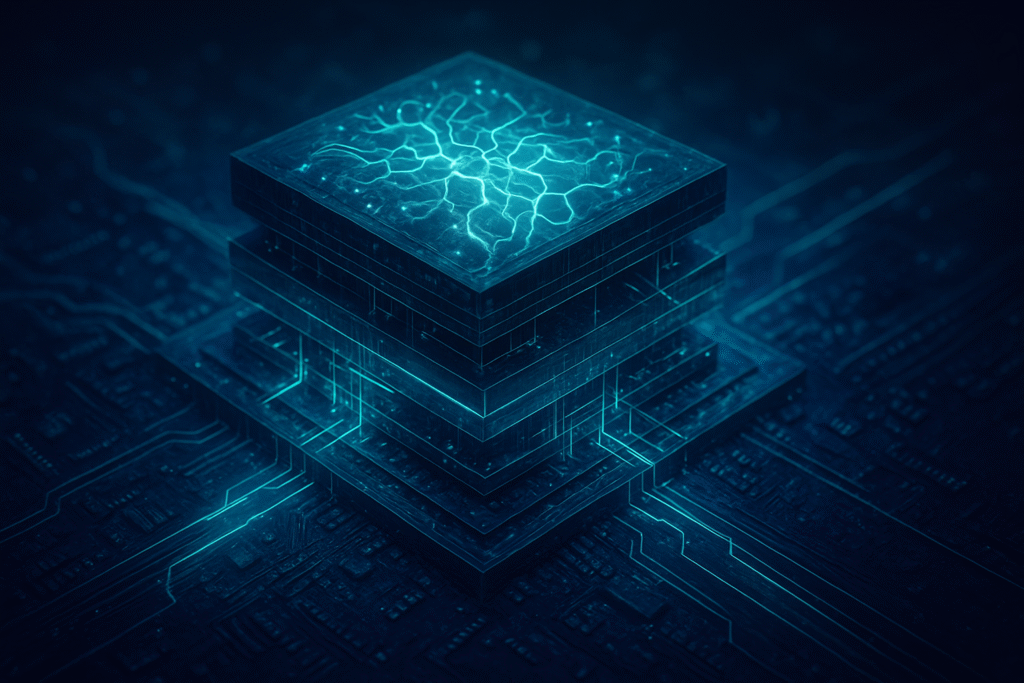Financial News
Advanced Packaging: The Unsung Hero Powering the Next-Generation AI Revolution

As Artificial Intelligence (AI) continues its relentless march into every facet of technology, the demands placed on underlying hardware have escalated to unprecedented levels. Traditional chip design, once the sole driver of performance gains through transistor miniaturization, is now confronting its physical and economic limits. In this new era, an often- overlooked yet critically important field – advanced packaging technologies – has emerged as the linchpin for unlocking the true potential of next-generation AI chips, fundamentally reshaping how we design, build, and optimize computing systems for the future. These innovations are moving far beyond simply protecting a chip; they are intricate architectural feats that dramatically enhance power efficiency, performance, and cost-effectiveness.
This paradigm shift is driven by the insatiable appetite of modern AI workloads, particularly large generative language models, for immense computational power, vast memory bandwidth, and high-speed interconnects. Advanced packaging technologies provide a crucial "More than Moore" pathway, allowing the industry to continue scaling performance even as traditional silicon scaling slows. By enabling the seamless integration of diverse, specialized components into a single, optimized package, advanced packaging is not just an incremental improvement; it is a foundational transformation that directly addresses the "memory wall" bottleneck and fuels the rapid advancement of AI capabilities across various sectors.
The Technical Marvels Underpinning AI's Leap Forward
The core of this revolution lies in several sophisticated packaging techniques that enable a new level of integration and performance. These technologies depart significantly from conventional 2D packaging, which typically places individual chips on a planar Printed Circuit Board (PCB), leading to longer signal paths and higher latency.
2.5D Packaging, exemplified by Taiwan Semiconductor Manufacturing Company (TSMC) (NYSE: TSM)'s CoWoS (Chip-on-Wafer-on-Substrate) and Intel (NASDAQ: INTC)'s Embedded Multi-die Interconnect Bridge (EMIB), involves placing multiple active dies—such as a powerful GPU and High-Bandwidth Memory (HBM) stacks—side-by-side on a high-density silicon or organic interposer. This interposer acts as a miniature, high-speed wiring board, drastically shortening interconnect distances from centimeters to millimeters. This reduction in path length significantly boosts signal integrity, lowers latency, and reduces power consumption for inter-chip communication. NVIDIA (NASDAQ: NVDA)'s H100 and A100 series GPUs, along with Advanced Micro Devices (AMD) (NASDAQ: AMD)'s Instinct MI300A accelerators, are prominent examples leveraging 2.5D integration for unparalleled AI performance.
3D Packaging, or 3D-IC, takes vertical integration to the next level by stacking multiple active semiconductor dies directly on top of each other. These layers are interconnected through Through-Silicon Vias (TSVs), tiny electrical conduits etched directly through the silicon. This vertical stacking minimizes footprint, maximizes integration density, and offers the shortest possible interconnects, leading to superior speed and power efficiency. Samsung (KRX: 005930)'s X-Cube and Intel's Foveros are leading 3D packaging technologies, with AMD utilizing TSMC's 3D SoIC (System-on-Integrated-Chips) for its Ryzen 7000X3D CPUs and EPYC processors.
A cutting-edge advancement, Hybrid Bonding, forms direct, molecular-level connections between metal pads of two or more dies or wafers, eliminating the need for traditional solder bumps. This technology is critical for achieving interconnect pitches below 10 µm, with copper-to-copper (Cu-Cu) hybrid bonding reaching single-digit micrometer ranges. Hybrid bonding offers vastly higher interconnect density, shorter wiring distances, and superior electrical performance, leading to thinner, faster, and more efficient chips. NVIDIA's Hopper and Blackwell series AI GPUs, along with upcoming Apple (NASDAQ: AAPL) M5 series AI chips, are expected to heavily rely on hybrid bonding.
Finally, Fan-Out Wafer-Level Packaging (FOWLP) is a cost-effective, high-performance solution. Here, individual dies are repositioned on a carrier wafer or panel, with space around each die for "fan-out." A Redistribution Layer (RDL) is then formed over the entire molded area, creating fine metal traces that "fan out" from the chip's original I/O pads to a larger array of external contacts. This approach allows for a higher I/O count, better signal integrity, and a thinner package compared to traditional fan-in packaging. TSMC's InFO (Integrated Fan-Out) technology, famously used in Apple's A-series processors, is a prime example, and NVIDIA is reportedly considering Fan-Out Panel Level Packaging (FOPLP) for its GB200 AI server chips due to CoWoS capacity constraints.
The initial reaction from the AI research community and industry experts has been overwhelmingly positive. Advanced packaging is widely recognized as essential for extending performance scaling beyond traditional transistor miniaturization, addressing the "memory wall" by dramatically increasing bandwidth, and enabling new, highly optimized heterogeneous computing architectures crucial for modern AI. The market for advanced packaging, especially for high-end 2.5D/3D approaches, is projected to experience significant growth, reaching tens of billions of dollars by the end of the decade.
Reshaping the AI Industry: A New Competitive Landscape
The advent and rapid evolution of advanced packaging technologies are fundamentally reshaping the competitive dynamics within the AI industry, creating new opportunities and strategic imperatives for tech giants and startups alike.
Companies that stand to benefit most are those heavily invested in custom AI hardware and high-performance computing. Tech giants like Google (NASDAQ: GOOGL), Amazon (NASDAQ: AMZN), and Microsoft (NASDAQ: MSFT) are leveraging advanced packaging for their custom AI chips (such as Google's Tensor Processing Units or TPUs and Microsoft's Azure Maia 100) to optimize hardware and software for their specific cloud-based AI workloads. This vertical integration provides them with significant strategic advantages in performance, latency, and energy efficiency. NVIDIA and AMD, as leading providers of AI accelerators, are at the forefront of adopting and driving these technologies, with NVIDIA's CEO Jensen Huang emphasizing advanced packaging as critical for maintaining a competitive edge.
The competitive implications for major AI labs and tech companies are profound. TSMC (NYSE: TSM) has solidified its dominant position in advanced packaging with technologies like CoWoS and SoIC, rapidly expanding capacity to meet escalating global demand for AI chips. This positions TSMC as a "System Fab," offering comprehensive AI chip manufacturing services and enabling collaborations with innovative AI companies. Intel (NASDAQ: INTC), through its IDM 2.0 strategy and advanced packaging solutions like Foveros and EMIB, is also aggressively pursuing leadership in this space, offering these services to external customers via Intel Foundry Services (IFS). Samsung (KRX: 005930) is restructuring its chip packaging processes, aiming for a "one-stop shop" approach for AI chip production, integrating memory, foundry, and advanced packaging to reduce production time and offering differentiated capabilities, as evidenced by its strategic partnership with OpenAI.
This shift also brings potential disruption to existing products and services. The industry is moving away from monolithic chip designs towards modular chiplet architectures, fundamentally altering the semiconductor value chain. The focus is shifting from solely front-end manufacturing to elevating the role of system design and emphasizing back-end design and packaging as critical drivers of performance and differentiation. This enables the creation of new, more capable AI-driven applications across industries, while also necessitating a re-evaluation of business models across the entire chipmaking ecosystem. For smaller AI startups, chiplet technology, facilitated by advanced packaging, lowers the barrier to entry by allowing them to leverage pre-designed components, reducing R&D time and costs, and fostering greater innovation in specialized AI hardware.
A New Era for AI: Broader Significance and Strategic Imperatives
Advanced packaging technologies represent a strategic pivot in the AI landscape, extending beyond mere hardware improvements to address fundamental challenges and enable the next wave of AI innovation. This development fits squarely within broader AI trends, particularly the escalating computational demands of large language models and generative AI. As traditional Moore's Law scaling encounters its limits, advanced packaging provides the crucial pathway for continued performance gains, effectively extending the lifespan of exponential progress in computing power for AI.
The impacts are far-reaching: unparalleled performance enhancements, significant power efficiency gains (with chiplet-based designs offering 30-40% lower energy consumption for the same workload), and ultimately, cost advantages through improved manufacturing yields and optimized process node utilization. Furthermore, advanced packaging enables greater miniaturization, critical for edge AI and autonomous systems, and accelerates time-to-market for new AI hardware. It also enhances thermal management, a vital consideration for high-performance AI processors that generate substantial heat.
However, this transformative shift is not without its concerns. The manufacturing complexity and associated costs of advanced packaging remain significant hurdles, potentially leading to higher production expenses and challenges in yield management. The energy-intensive nature of these processes also raises environmental impact concerns. Additionally, for AI to further optimize packaging processes, there's a pressing need for more robust data sharing and standardization across the industry, as proprietary information often limits collaborative advancements.
Comparing this to previous AI milestones, advanced packaging represents a hardware-centric breakthrough that directly addresses the physical limitations encountered by earlier algorithmic advancements (like neural networks and deep learning) and traditional transistor scaling. It's a paradigm shift that moves away from monolithic chip designs towards modular chiplet architectures, offering a level of flexibility and customization at the hardware layer akin to the flexibility offered by software frameworks in early AI. This strategic importance cannot be overstated; it has become a competitive differentiator, democratizing AI hardware development by lowering barriers for startups, and providing the scalability and adaptability necessary for future AI systems.
The Horizon: Glass, Light, and Unprecedented Integration
The future of advanced packaging for AI chips promises even more revolutionary developments, pushing the boundaries of integration, performance, and efficiency.
In the near term (next 1-3 years), we can expect intensified adoption of High-Bandwidth Memory (HBM), particularly HBM4, with increased capacity and speed to support ever-larger AI models. Hybrid bonding will become a cornerstone for high-density integration, and heterogeneous integration with chiplets will continue to dominate, allowing for modular and optimized AI accelerators. Emerging technologies like backside power delivery will also gain traction, improving power efficiency and signal integrity.
Looking further ahead (beyond 3 years), truly transformative changes are on the horizon. Co-Packaged Optics (CPO), which integrates optical I/O directly with AI accelerators, is poised to replace traditional copper interconnects. This will drastically reduce power consumption and latency in multi-rack AI clusters and data centers, enabling faster and more efficient communication crucial for massive data movement.
Perhaps one of the most significant long-term developments is the emergence of Glass-Core Substrates. These are expected to become a new standard, offering superior electrical, thermal, and mechanical properties compared to organic substrates. Glass provides ultra-low warpage, superior signal integrity, better thermal expansion matching with silicon, and enables higher-density packaging (supporting sub-2-micron vias). Intel projects complete glass substrate solutions in the second half of this decade, with companies like Samsung, Corning, and TSMC actively investing in this technology. While challenges exist, such as the brittleness of glass and manufacturing costs, its advantages for AI, HPC, and 5G are undeniable.
Panel-Level Packaging (PLP) is also gaining momentum as a cost-effective alternative to wafer-level packaging, utilizing larger panel substrates to increase throughput and reduce manufacturing costs for high-performance AI packages.
Experts predict a dynamic period of innovation, with the advanced packaging market projected to grow significantly, reaching approximately $80 billion by 2030. The package itself will become a crucial point of innovation and a differentiation driver for system performance, with value creation migrating towards companies that can design and integrate complex, system-level chip solutions. The accelerated adoption of hybrid bonding, TSVs, and advanced interposers is expected, particularly for high-end AI accelerators and data center CPUs. Major investments from key players like TSMC, Samsung, and Intel underscore the strategic importance of these technologies, with Intel's roadmap for glass substrates pushing Moore's Law beyond 2030. The integration of AI into electronic design automation (EDA) processes will further accelerate multi-die innovations, making chiplets a commercial reality.
A New Foundation for AI's Future
In conclusion, advanced packaging technologies are no longer merely a back-end manufacturing step; they are a critical front-end innovation driver, fundamentally powering the AI revolution. The convergence of 2.5D/3D integration, HBM, heterogeneous integration, the nascent promise of Co-Packaged Optics, and the revolutionary potential of glass-core substrates are unlocking unprecedented levels of performance and efficiency. These advancements are essential for the continued development of more sophisticated AI models, the widespread integration of AI across industries, and the realization of truly intelligent and autonomous systems.
As we move forward, the semiconductor industry will continue its relentless pursuit of innovation in packaging, driven by the insatiable demands of AI. Key areas to watch in the coming weeks and months include further announcements from leading foundries on capacity expansion for advanced packaging, new partnerships between AI hardware developers and packaging specialists, and the first commercial deployments of emerging technologies like glass-core substrates and CPO in high-performance AI systems. The future of AI is intrinsically linked to the ingenuity and advancements in how we package our chips, making this field a central pillar of technological progress.
This content is intended for informational purposes only and represents analysis of current AI developments.
TokenRing AI delivers enterprise-grade solutions for multi-agent AI workflow orchestration, AI-powered development tools, and seamless remote collaboration platforms. For more information, visit https://www.tokenring.ai/.
More News
View More




Recent Quotes
View More
Quotes delayed at least 20 minutes.
By accessing this page, you agree to the Privacy Policy and Terms Of Service.



